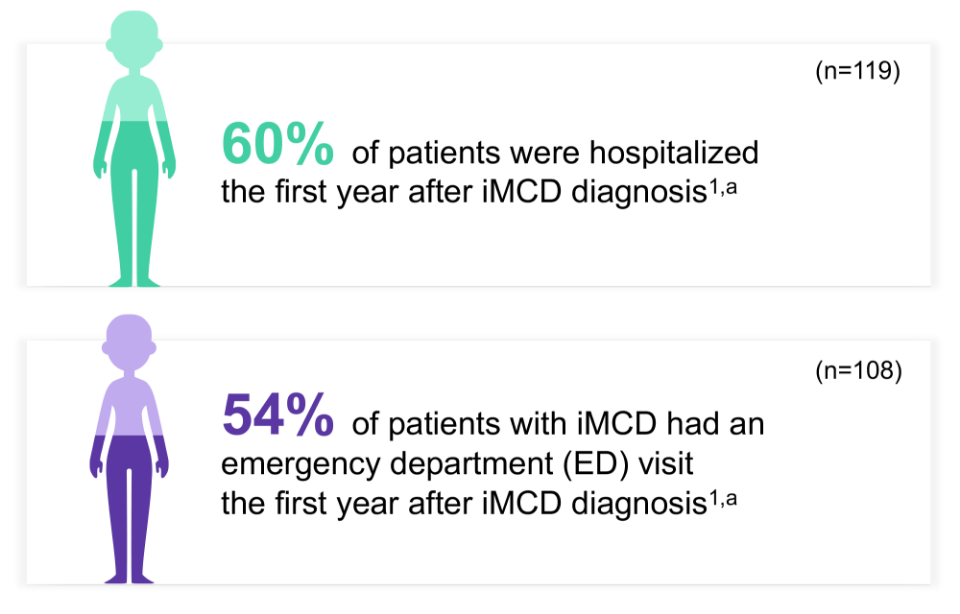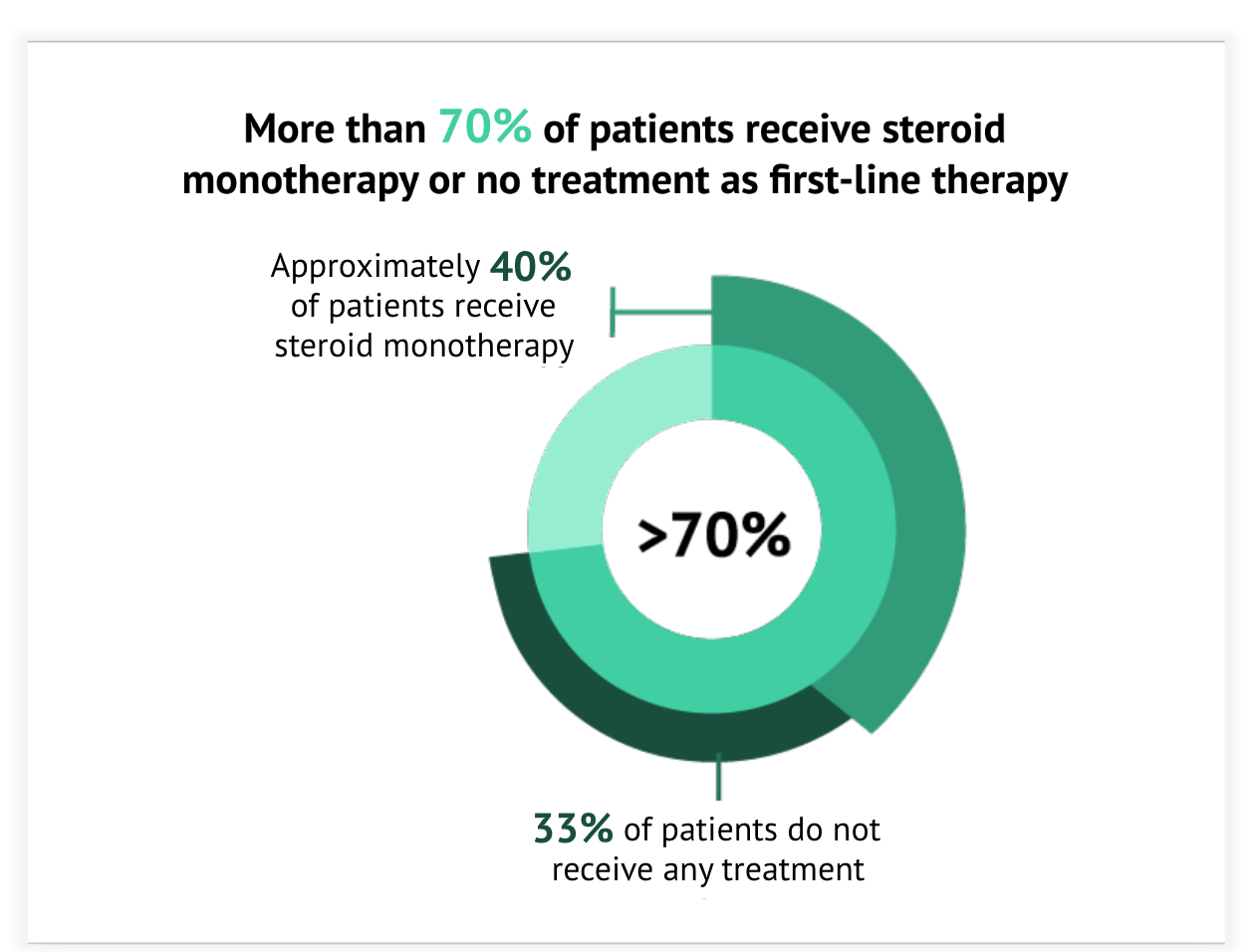Treating patients with iMCD
Treating patients with iMCD
There are various therapies being used in the treatment of patients with iMCD. The CDCN, the
same group that published the first consensus diagnostic criteria, has developed formal
guidelines for the treatment of iMCD.5

Timely
Diagnosis
Timely diagnosis and appropriate treatment can help bring the symptoms of iMCD under
control.3

Ongoing
Treatment
Considering the chronic and progressive nature of iMCD, patients will need to receive
ongoing treatment to keep their symptoms under control.5,6

Following Treatment Guidelines
Evidence-based treatment guidelines have been developed to help healthcare professionals
treat their patients with iMCD.5

Learn more about an iMCD treatment that may be right for your patient
Different journeys. Same fighting spirit.
Hear from the people who have been fighting iMCD for years, and learn how they have dealt
with some of the challenges they have experienced.
Sign up for more on iMCD
"*" indicates required fields
By checking the adjacent box, you agree to allow EUSA Pharma to collect the information provided and to be contacted by EUSA Pharma in the future regarding its IL-6 neutralizing products and related disease education.
By submitting this form, you agree to allow EUSA Pharma to collect the information provided and to be contacted directly by a EUSA Pharma sales representative. Your information will not be used for any other purpose than for a representative to respond to your information request, or for us to send you other EUSA Pharma updates if you have registered to receive them.
EUSA Pharma will not sell, rent, or otherwise distribute your name and any personally identifiable information outside of EUSA Pharma. EUSA Pharma will only use your information in accordance with its Privacy Policy.
-
Mukherjee S, Martin R, Sande B, et al. A longitudinal population level analysis of healthcare resource utilization, comorbidity, and survival in idiopathic multicentric Castleman disease patients. Presented at: 62nd American Society of Hematology (ASH) Annual Meeting and Exposition; December 5-8, 2020; virtual meeting.
-
Mukherjee S, Martin R, Sande B, et al. A longitudinal population level analysis of healthcare resource utilization, comorbidity, and survival in idiopathic multicentric Castleman disease patients. Blood. 2020;136(suppl 1):11.
-
Fajgenbaum DC, Uldrick TS, Bagg A, et al. International, evidence-based consensus diagnostic criteria for HHV-8–negative/idiopathic multicentric Castleman disease. Blood. 2017;129(12):1646-1657.
-
Mukherjee S, Martin R, Sande B, Paige JS, Fajgenbaum DC. Epidemiology and treatment patterns of idiopathic multicentric Castleman disease in the era of IL-6-directed therapy. Blood Adv. 2022;6(2):359-367.
-
van Rhee F, Voorhees P, Dispenzieri A, et al. International, evidence-based consensus treatment guidelines for idiopathic multicentric Castleman disease. Blood. 2018;132(20):2115 -2124.
-
Referenced with permission from the NCCN Clinical Practice Guidelines in Oncology (NCCN Guidelines®) for B-Cell Lymphomas V.3.2022. © National Comprehensive Cancer Network, Inc. 2022. All rights reserved. Accessed April 29, 2022. To view the most recent and complete version of the guideline, go online to NCCN.org. NCCN makes no warranties of any kind whatsoever regarding their content, use or application and disclaims any responsibility for their application or use in any way.
Your iMCD Diary
Save and use this Patient Diary online with your Google account by selecting “Google Sheet” and then “Use Template,” or download to your computer by selecting “Excel File.”
No data is stored by or transferred to this KnowiMCD.com website. This site contains links to other websites, and these links will direct users to third-party sites.
Loading...
Please wait a moment.
Are you located in the United States?
If so, you will be directed to the website that contains information intended for a US audience.
Viral hemophagocytic lymphohistiocytosis.
A doctor who specializes in the branch of medicine that deals with rheumatic conditions.
Polyneuropathy, organomegaly, endocrinopathy, monoclonal gammopathy, and skin changes.
Positron emission tomography (PET) is a method of producing a 3-dimensional image of the internal
structures of body tissues after administering a natural biochemical substance like glucose or fatty
acids. These images are generated with the help of a computer.
A doctor who evaluates the changes caused by disease in tissues and body fluids and helps reach a
diagnosis.
A doctor who specializes in the diagnosis and treatment of kidney abnormalities.
Macrophage activation syndrome.
Malignancy-associated hemophagocytic lymphohistiocytosis.
A disease in which cells of the lymph system grow excessively
Lymph nodes make immune cells that help the body fight infection.
A key signaling molecule that helps to regulate the body’s immune system.
Infectious disease medicine is the subspecialty of internal medicine that focuses on diagnosing and
managing infections.
A rare condition that affects multiple groups of lymph nodes throughout the body. Patients with iMCD
are HIV negative and HHV-8 negative.
The underlying cause or origin of a disease is unknown.
Hemophagocytic lymphohistiocytosis.
Human immunodeficiency virus.
Human herpesvirus-8.
A doctor who specializes in the branch of medical science that deals with cancers of the blood and
blood-forming tissues.
Powerful molecules that are normally secreted by the cells of the immune system in response to
infectious or noninfectious agents.
An overreaction of the body’s immune system in which too many cytokines are released into the
bloodstream very quickly, with potentially severe or life-threatening effects.
Computed tomography (CT) is a method of producing an image of the internal structures by passing an
x‑ray through the body.
The removal and examination of tissue, cells, or fluids from the body.
A condition in which the body’s immune system accidentally attacks itself.
Autoimmune lymphoproliferative syndrome.
You are now leaving KnowiMCD.com.
Please click “OK” to continue or “CANCEL” to return to KnowiMCD.com







